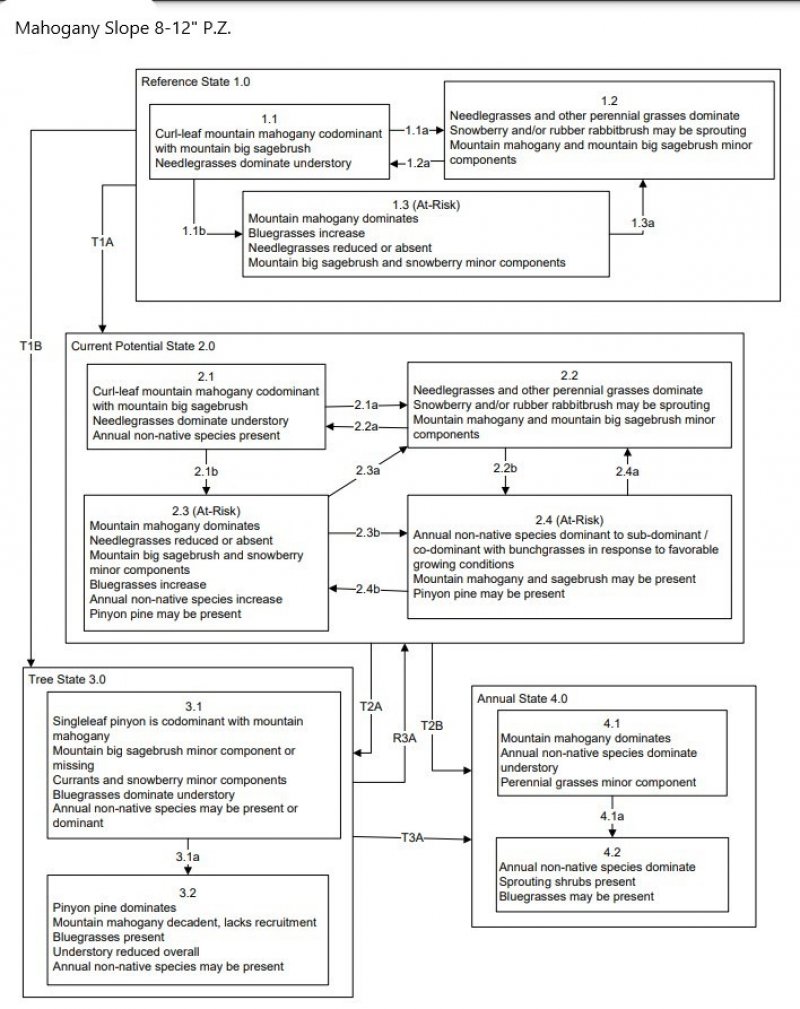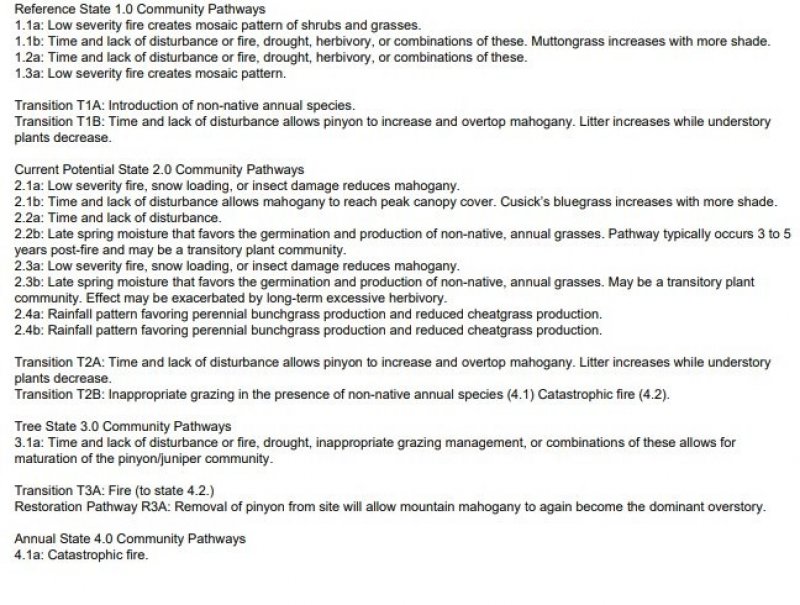Ecological dynamics
Where management results in abusive livestock and big game use, the under-story grasses and forbs decrease while mountain big sagebrush and snowberry increase. Species likely to invade this site are annuals such as cheatgrass.
This is a general text description of the states, phases, transitions, and community pathways possible in the State and Transition model for the MLRA 26 Disturbance Response Group 15. Site included in this Disturbance Response Group are R026XY009NV and R026XY015CA.
Reference State 1.0:
The Reference State 1.0 represents the natural range of variability under pristine conditions. The reference state has three general community phases; a shrub-grass dominant phase, a perennial grass dominant phase and a shrub dominant phase. State dynamics are maintained by interactions between climatic patterns and disturbance regimes. Negative feedbacks enhance ecosystem resilience and contribute to the stability of the state. These include the presence of all structural and functional groups, low fine fuel loads, and retention of organic matter and nutrients. Plant community phase changes are primarily driven by fire, periodic drought and/or insect or disease attack.
Community Phase 1.1:
This community is dominated by curl-leaf mountain mahogany. Mountain big sagebrush and snowberry make up the shrub components of the understory. Needlegrasses and bluegrasses are dominant perennial bunchgrasses. A diversity of other grasses and forbs exist in the understory.
Community Phase Pathway 1.1a from phase 1.1 to 1.2:
Fire will reduce the mahogany overstory and allow the understory species to dominate the site. Due to low fuel loads, fires will typically be low severity, resulting in a mosaic pattern.
Community Phase Pathway 1.1b from phase 1.1 to 1.3:
Time and lack of disturbance or fire, drought, herbivory, or combinations of these causes mountain mahogany to increase. The shrub and herbaceous understory components decline due to increased shading from the trees. Muttongrass increases with more shade.
Community Phase 1.2:
This community phase is characteristic of a post-disturbance, early- to mid-seral plant community. Snowberry and rabbitbrush are sprouting. Perennial grasses and forbs dominate. Mahogany and mountain big sagebrush may be present, but only in patches.
Community Phase Pathway 1.2a from phase 1.2 to 1.1:
Time and lack of disturbance or fire, drought, herbivory, or combinations of these allows the mountain mahogany and sagebrush to increase.
Community Phase 1.3 (At-Risk):
Mahogany density will increase in the absence of disturbance. Shrubs and deep-rooted perennial bunchgrasses will be shaded out by the dense mahogany. Bluegrasses are more shade tolerant, however, and increase in the understory. Mahogany in dense stands will lose lower branches due to shading and/or herbivory, resulting in a more tree-like appearance.
Community Phase Pathway 1.3a fro, phase 1.3 to 1.2:
A low-severity or spot fire, snow loading, or insect damage will decrease the overstory and allow for the herbaceous plants in the understory to increase.
T1A: Transition from Reference State 1.0 to Current Potential State 2.0:
Trigger: This transition is caused by the introduction of non-native annual weeds, such as cheatgrass, mustard and Russian thistle. These non-native species were often introduced with livestock grazing.
Slow variables: Over time, the annual non-native plants will increase within the community decreasing organic matter inputs from deep-rooted perennial bunchgrasses resulting in reductions in soil water availability for perennial bunchgrasses.
Threshold: Any amount of introduced non-native species causes an immediate decrease in the resilience of the site. Annual non-native species cannot be easily removed from the system and have the potential to significantly alter disturbance regimes from their historic range of variation.
T1B: Transition from Reference State 1.0 to Tree State 3.0:
Trigger: Time and lack of disturbance allows pinyon to increase and overtop the mountain mahogany. Litter increases while understory plants decrease.
Slow variables: Over time, abundance and size of singleleaf pinyon will increase.
Threshold: Pinyon dominate(s) ecological processes. Trees overtop and outcompete mountain mahogany and shrubs for water and sunlight. Shrub skeletons exceed live shrubs with minimal recruitment of new cohorts.
Current Potential State 2.0:
This state is similar to the Reference State 1.0. Ecological function has not changed, however the resiliency of the state has been reduced by the presence of invasive weeds. This state has the same three general community phases. Negative feedbacks enhance ecosystem resilience and contribute to the stability of the state. These include the presence of all structural and functional groups, low fine fuel loads and retention of organic matter and nutrients. Positive feedbacks decrease ecosystem resilience and stability of the state. These include the non-natives high seed output, persistent seed bank, rapid growth rate, ability to cross-pollinate and adaptations for seed dispersal. Additionally, the presence of highly flammable, non-native species reduces State resilience because these species can promote fire where historically fire has been infrequent leading to positive feedbacks that further the degradation of the system.
Community Phase 2.1:
This community is dominated by curl-leaf mountain mahogany. Mountain big sagebrush and snowberry make up the shrub components of the understory. Needlegrasses and bluegrasses are dominant perennial bunchgrasses. A diversity of other grasses and forbs exist in the understory. Annual non-native species like cheatgrass are present.
Community Phase Pathway 2.1a from phase 2.1 to 2.2:
Fire will decrease or eliminate the overstory of mahogany and allow the perennial bunchgrasses to dominate the site. Fires will typically be small and patchy due to low fuel loads.
Community Phase Pathway 2.1b from phase 2.1 to 2.3:
Time and lack of disturbance or fire, drought, herbivory, or combinations of these causes mountain mahogany to increase. The shrub and herbaceous understory components decline due to increased shading from the mahogany and/or pinyon pine. Muttongrass increases with more shade.
Community Phase 2.2:
This community phase is characteristic of a post-disturbance, early to mid-seral community phase. Needlegrasses and other perennial grasses dominate the site. Snowberry and/or rubber rabbitbrush may be sprouting. Mountain mahogany and mountain big sagebrush are patchy. Annual non-native species are present.
Community Phase Pathway 2.2a from phase 2.2 to 2.1:
Time and lack of disturbance or fire, drought, herbivory, or combinations of these allows the mountain mahogany and sagebrush to increase.
Community Phase Pathway 2.2b from phase 2.2 to 2.4:
Higher than normal spring precipitation favors annual non-native species such as cheatgrass. Non-native annual species will increase in production and density throughout the site. Perennial bunchgrasses may also increase in production. Fire may also play a part in this pathway.
Community Phase 2.3 (At-Risk):
Mahogany density will increase in the absence of disturbance. Shrubs and deep-rooted perennial bunchgrasses will be shaded out by the dense mahogany. Bluegrasses are more shade tolerant, however, and increase in the understory. Mahogany in dense stands will lose lower branches due to shading and/or herbivory, resulting in a more tree-like appearance. Pinyon pine may be present.
Community Phase Pathway 2.3a from phase 2.3 to 2.2:
Fire reduces the shrub overstory and allows perennial bunchgrasses to dominate the site. Fires are typically low severity resulting in a mosaic pattern due to low fuel loads. A fire following an unusually wet spring or a change in management favoring an increase in fine fuels may be more severe and reduce sagebrush cover to trace amounts. Annual non-native species are likely to increase after fire.
Community Phase Pathway 2.3b from phase 2.3 to 2.4:
Fall, winter, and spring precipitation and temperatures mediate the ability for annual grasses and perennial grasses to germinate and/or survive. Higher than normal spring precipitation creates high annual production of annual grasses (Bradley et al. 2016). Non-native annual species increase in production and density throughout the site. Perennial bunchgrasses may also increase in production.
Community Phase 2.4 (At-Risk):
This community is at risk of crossing into an annual state. Native bunchgrasses dominate; however, annual non-native species such as cheatgrass may be sub- or co-dominant in the understory. Annual production and abundance of these annuals may increase drastically in years with heavy spring precipitation. This site is susceptible to further degradation from grazing, drought, and fire. Pinyon pine may be present.
T2A: Transition from Current Potential State 2.0 to Tree State 3.0:
Trigger: Time and lack of disturbance allows pinyon to increase and overtop the mountain mahogany. Litter increases while understory plants decrease.
Slow variables: Over time, abundance and size of pinyon will increase.
Threshold: Pinyon pine dominate(s) ecological processes. Trees overtop and outcompete mountain mahogany and shrubs for water and sunlight. Shrub skeletons exceed live shrubs with minimal recruitment of new cohorts.
T2B: Transition from Current Potential State 2.0 to Annual State 4.0:
Trigger: Fire or a failed range seeding leads to plant community phase 4.1. Inappropriate grazing management that favors shrubs in the presence of non-native annual species leads to community phase 4.2.
Slow variables: Increased production and cover of non-native annual species.
Threshold: Cheatgrass or other non-native annuals dominate understory.
Tree State 3.0:
This state has two community phases that are characterized by the dominance of singleleaf pinyon in the overstory. Mountain big sagebrush and perennial bunchgrasses may still be present, but they are no longer controlling site resources. Soil moisture, soil nutrients, soil organic matter distribution and nutrient cycling have been spatially and temporally altered.
Community Phase 3.1:
Pinyon pine and mountain mahogany dominate the site. Mountain big sagebrush and snowberry are minor component. Bluegrasses dominate understory. Annual non-native species may be present or dominant.
Community Phase Pathway 3.1a from phase 3.1 to 3.2:
Time and lack of disturbance or fire, drought, inappropriate grazing management, or combinations of these allows for maturation of the pinyon/juniper community.
Community Phase 3.2:
Pinyon pine dominates the site. Mountain mahogany is decadent and the stand lacks recruitment. Bluegrasses are present. Understory is reduced overall. Annual non-native species may be present.
T3A: Transition from Tree State 3.0 to Annual State 4.0:
Trigger: To community phase 4.1: Overgrazing in the presence of non-native annual species can cause a decrease in perennial bunchgrasses and an increase in annual species. Spring and/or fall moisture may also increase annual species. To community phase 4.2: Fire in the presence of annual invasive grasses.
Slow variables: Cover and production of annual non-native species increase in the understory.
Threshold: Loss of mahogany overstory, mountain big sagebrush, and deep-rooted perennial bunchgrasses changes nutrient cycling, nutrient redistribution, and reduces soil organic matter. Increased, continuous fine fuels modify the fire regime by changing intensity, size and spatial variability of fires.
R3A: Restoration from Tree State 3.0 to Current Potential State 2.0:
Removal of pinyon from site will allow mountain mahogany to again become the dominant overstory.
Annual State 4.0:
This state has two community phases: one with annual invasive plants in the understory of an intact mahogany stand, and another post-fire phase where mahogany is a minor component or missing from the site. This state is characterized by the dominance of annual non-native species such as cheatgrass and/or tansy mustard in the understory. Ecological dynamics are significantly altered in this state. Annual non-native species create a highly combustible fuel bed that shortens the fire return interval. Nutrient cycling is spatially and temporally truncated as annual plants contribute significantly less to deep soil carbon. Because this is a productive site, some deep-rooted perennial grasses may remain, even in the annual state. Without management, it is unlikely these plants will be able to recruit in the presence of dominant annual grasses.
Community Phase 4.1:
Mountain mahogany dominates the overstory and annual non-native plants such as cheatgrass dominate the understory. Native perennial grasses and forbs are significantly reduced. Sagebrush and snowberry may or may not be present.
Community Phase Pathway 4.1a:
Catastrophic fire reduces the mountain mahogany overstory and allows annual species to dominate.
Community Phase 4.2:
Annual non-native species dominate the site. The open canopy may allow sprouting shrubs and bluegrasses to increase.
Community 1.1
Reference Community Phase 1.1
The plant community is dominated by curl-leaf mountain mahogany, mountain big sagebrush, and needlegrass. Potential vegetation composition is about 50% trees and tree-like shrubs, 20 percent shrubs, 25 percent grasses, and 5 percent forbs.


